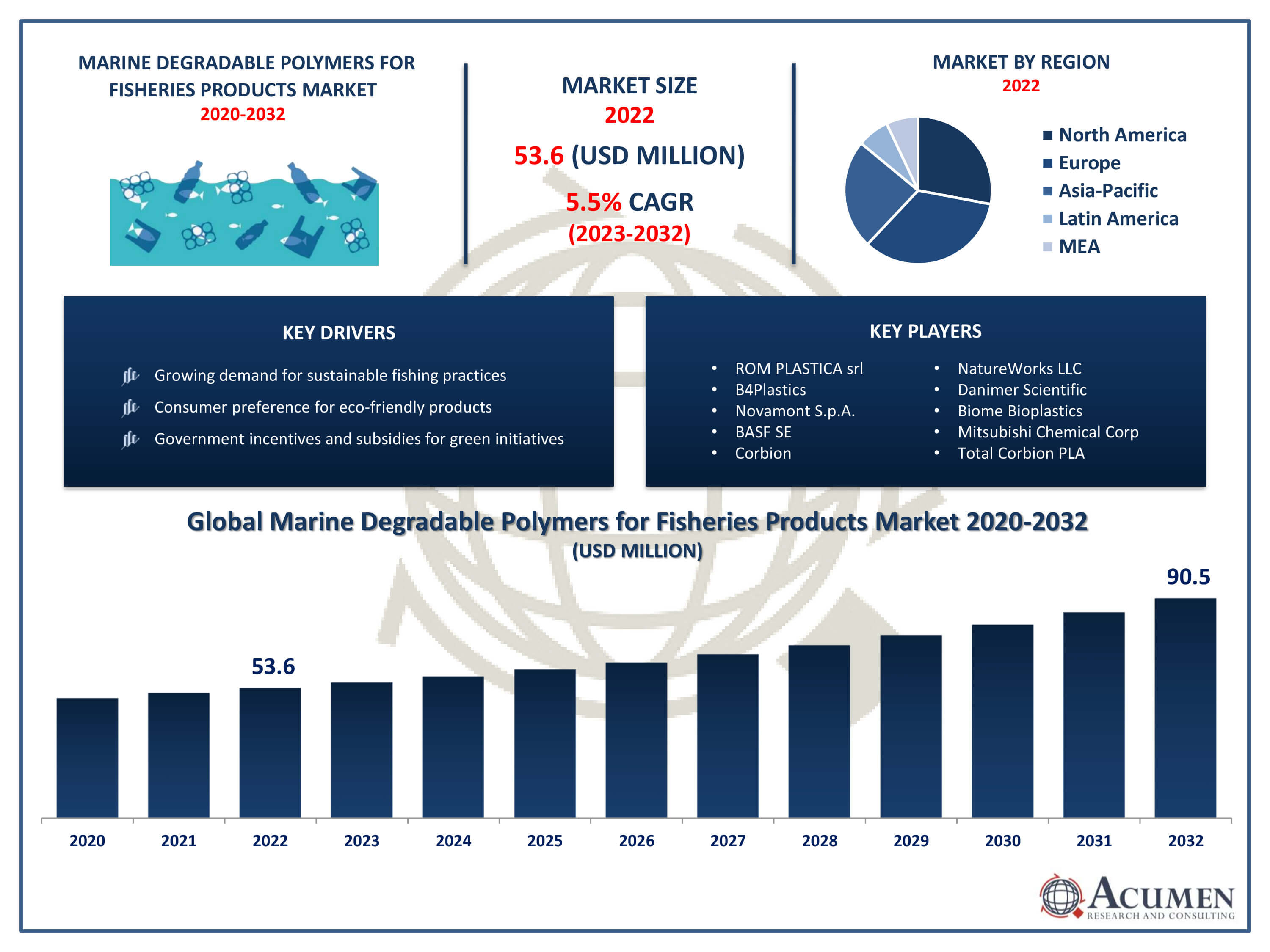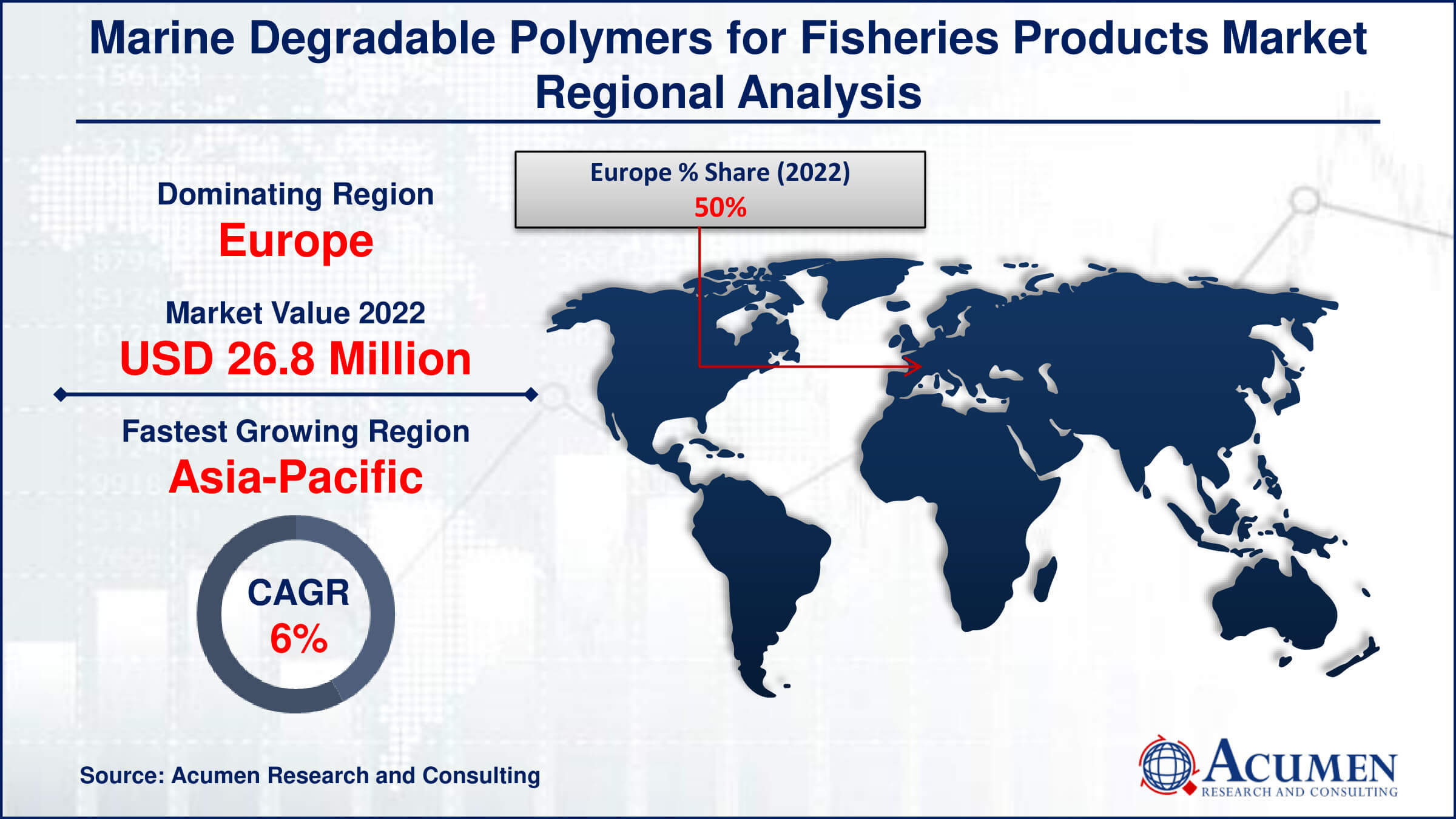Marine Degradable Polymers For Fisheries Products Market | Acumen Research and Consulting
Marine Degradable Polymers for Fisheries Products Market Size - Global Industry, Share, Analysis, Trends and Forecast 2023 - 2032
Published :
Report ID:
Pages :
Format :
The Marine Degradable Polymers for Fisheries Products Market Size accounted for USD 53.6 Million in 2022 and is projected to achieve a market size of USD 90.5 Million by 2032 growing at a CAGR of 5.5% from 2023 to 2032.
Marine Degradable Polymers for Fisheries Products Market Highlights
- Global marine degradable polymers for fisheries products market revenue is expected to increase by USD 90.5 Million by 2032, with a 5.5% CAGR from 2023 to 2032
- Europe region led with more than 50% of marine degradable polymers for fisheries products market share in 2022
- Asia-Pacific marine degradable polymers for fisheries products market growth will record a CAGR of more than 6.3% from 2023 to 2032
- By product, the bottom trawlis the largest segment of the market, accounting for over 75% of the global market share
- By material, the Polybutylene Succinate (PBS) is one of the largest and fastest-growing segments of the market
- Increasing environmental awareness and regulations on plastic pollution, drives the marine degradable polymers for fisheries products market value

Marine degradable polymers for fisheries products refer to materials used in the fishing industry that have the ability to break down in marine environments, reducing the environmental impact of discarded or lost fishing gear. These polymers are designed to degrade through natural processes when exposed to marine conditions, such as sunlight, water, and microbial action, ultimately reducing the persistence of plastic pollution in oceans and marine ecosystems. They offer a promising solution to mitigate the ecological harm caused by conventional non-degradable plastics commonly used in fishing gear.
The market for marine degradable polymers in fisheries products has been experiencing steady growth in recent years, driven by increasing awareness of marine pollution and stricter regulations on plastic waste management. Governments and environmental organizations worldwide are advocating for sustainable fishing practices and the adoption of eco-friendly materials in the fishing industry. As a result, there's a growing demand for marine degradable polymers among fishing companies seeking to align with sustainability goals and reduce their environmental footprint. Additionally, consumers are becoming more environmentally conscious, prompting companies to invest in greener alternatives, further driving market expansion for marine degradable polymers in fisheries products.
Global Marine Degradable Polymers for Fisheries Products Market Trends
Market Drivers
- Increasing environmental awareness and regulations on plastic pollution
- Growing demand for sustainable fishing practices
- Consumer preference for eco-friendly products
- Government incentives and subsidies for green initiatives
- Technological advancements improving the performance of marine degradable polymers
Market Restraints
- Challenges in scalability and cost-effectiveness
- Limited availability of suitable alternatives
Market Opportunities
- Expansion of eco-certified fisheries
- Development of biodegradable alternatives for various fishing gear applications
Marine Degradable Polymers for Fisheries Products Market Report Coverage
| Market | Marine Degradable Polymers for Fisheries Products Market |
| Marine Degradable Polymers for Fisheries Products Market Size 2022 | USD 53.6 Billion |
| Marine Degradable Polymers for Fisheries Products Market Forecast 2032 |
USD 90.5 Billion |
| Marine Degradable Polymers for Fisheries Products Market CAGR During 2023 - 2032 | 5.5% |
| Marine Degradable Polymers for Fisheries Products Market Analysis Period | 2020 - 2032 |
| Marine Degradable Polymers for Fisheries Products Market Base Year |
2022 |
| Marine Degradable Polymers for Fisheries Products Market Forecast Data | 2023 - 2032 |
| Segments Covered | By Material, By Product, And By Geography |
| Regional Scope | North America, Europe, Asia Pacific, Latin America, and Middle East & Africa |
| Key Companies Profiled | ROM PLASTICA srl, B4Plastics, Novamont S.p.A., BASF SE, Corbion, NatureWorks LLC, Danimer Scientific, Biome Bioplastics, Mitsubishi Chemical Corporation, Total Corbion PLA, Arkema Group, and FKuR Kunststoff GmbH. |
| Report Coverage |
Market Trends, Drivers, Restraints, Competitive Analysis, Player Profiling, Covid-19 Analysis, Regulation Analysis |
Marine degradable polymers for fisheries products are specialized materials designed to break down in marine environments, addressing the significant issue of plastic pollution in oceans and waterways. These polymers offer a sustainable alternative to conventional plastics commonly used in fishing gear, such as nets, lines, and traps. By utilizing marine degradable polymers, the fishing industry can reduce its environmental impact by minimizing the accumulation of non-degradable plastic waste in marine ecosystems. Applications of marine degradable polymers in fisheries products span across various aspects of fishing gear and equipment. Nets made from these polymers provide a biodegradable alternative to traditional nylon nets, reducing the risk of ghost fishing and entanglement of marine life. Similarly, lines and ropes manufactured using marine degradable polymers offer durability and strength while ensuring they degrade over time in marine environments, minimizing their persistence in the ocean.
The market for marine degradable polymers in fisheries products has witnessed significant growth in recent years, driven by escalating concerns over plastic pollution in marine environments. As the detrimental effects of conventional plastics on marine ecosystems become more apparent, there is a growing demand for sustainable alternatives within the fishing industry. Marine degradable polymers offer a promising solution, as they are designed to break down naturally in marine environments, reducing the persistence of plastic waste and minimizing ecological harm. Several factors contribute to the growth of this market. Heightened environmental awareness among consumers and stringent regulations on plastic waste management propel the adoption of marine degradable polymers by fisheries companies seeking to align with sustainability goals. Additionally, technological advancements have enhanced the performance and cost-effectiveness of these materials, making them increasingly attractive to businesses looking to reduce their environmental footprint.
Marine Degradable Polymers for Fisheries Products Market Segmentation
The global marine degradable polymers for fisheries products market segmentation is based on material, product, and geography.
Marine Degradable Polymers for Fisheries Products Market By Material
- Polybutylene Succinate (PBS)
- Polybutylene Adipate Terephthalate (PBAT)
In terms of materials, the polybutylene succinate (PBS) segment accounted for a significant market share in 2022. PBS is a biodegradable polymer derived from renewable resources, making it an attractive alternative to conventional plastics in the fishing industry. Its properties, including biodegradability and mechanical strength, make it well-suited for various applications in fisheries products such as fishing nets, ropes, and packaging materials. Several factors contribute to the growth of the PBS segment in this market. Increasing awareness of marine pollution and stringent regulations on plastic waste disposal drive the demand for eco-friendly alternatives like PBS in the fishing industry. Furthermore, technological advancements have enhanced the performance of PBS, making it increasingly competitive with traditional plastics in terms of durability and cost-effectiveness. Additionally, partnerships between research institutions, governments, and industry stakeholders facilitate innovation and the development of novel PBS formulations tailored to the specific needs of the fisheries sector.
Marine Degradable Polymers for Fisheries Products Market By Product
- Gillnet
- Fishing Trap
- Dollyrope
- Bottom Trawl
According to the marine degradable polymers for fisheries products market forecast, the bottom trawl segment is expected to witness significant growth in the coming years. Bottom trawling is a common fishing method that involves dragging nets along the seabed to catch fish and other marine species. However, traditional trawl nets are often made of non-degradable plastics, leading to environmental concerns such as ghost fishing and marine pollution. As a result, there is a growing interest in replacing these conventional nets with marine degradable polymers to mitigate their environmental impact. Several factors contribute to the growth of the bottom trawl segment in this market. Heightened awareness of marine pollution and regulatory initiatives aimed at reducing plastic waste drive the adoption of marine degradable polymers in bottom trawl fishing gear. Moreover, advancements in polymer technology have led to the development of durable and biodegradable alternatives that offer comparable performance to traditional nets. Additionally, collaborations between fishing companies, research institutions, and government agencies facilitate the development and adoption of innovative bottom trawl designs incorporating marine degradable polymers.
Marine Degradable Polymers for Fisheries Products Market Regional Outlook
North America
- U.S.
- Canada
Europe
- U.K.
- Germany
- France
- Spain
- Rest of Europe
Asia-Pacific
- India
- Japan
- China
- Australia
- South Korea
- Rest of Asia-Pacific
Latin America
- Brazil
- Mexico
- Rest of Latin America
The Middle East & Africa
- South Africa
- GCC Countries
- Rest of the Middle East & Africa (ME&A)

Marine Degradable Polymers for Fisheries Products Market Regional Analysis
Europe has emerged as a dominating region in the marine degradable polymers for fisheries products market due to several key factors. First and foremost, Europe has been at the forefront of environmental consciousness and sustainable practices, leading to stringent regulations and policies aimed at reducing plastic pollution in marine ecosystems. These regulations have spurred the adoption of marine degradable polymers in the fisheries industry as a means to mitigate the environmental impact of discarded fishing gear and packaging materials. Furthermore, Europe boasts a robust research and development infrastructure dedicated to advancing sustainable technologies, including marine degradable polymers. Research institutions, universities, and private companies in Europe are actively engaged in developing innovative polymer formulations and manufacturing processes tailored to the needs of the fisheries sector. This focus on innovation has resulted in the development of high-performance marine degradable polymers that meet the rigorous demands of fishing gear and packaging applications. Moreover, Europe's strong commitment to sustainability has fostered collaboration among industry stakeholders, government bodies, and environmental organizations. These collaborative efforts have facilitated the adoption of marine degradable polymers across the fisheries supply chain, from fishing companies to packaging manufacturers to retailers.
Marine Degradable Polymers for Fisheries Products Market Player
Some of the top marine degradable polymers for fisheries products market companies offered in the professional report include ROM PLASTICA srl, B4Plastics, Novamont S.p.A., BASF SE, Corbion, NatureWorks LLC, Danimer Scientific, Biome Bioplastics, Mitsubishi Chemical Corporation, Total Corbion PLA, Arkema Group, and FKuR Kunststoff GmbH.
Frequently Asked Questions
How big is the marine degradable polymers for fisheries products market?
The marine degradable polymers for fisheries products market size was USD 53.6 Million in 2022.
What is the CAGR of the global marine degradable polymers for fisheries products market from 2023 to 2032?
The CAGR of marine degradable polymers for fisheries products is 5.5% during the analysis period of 2023 to 2032.
Which are the key players in the marine degradable polymers for fisheries products market?
The key players operating in the global market are including ROM PLASTICA srl, B4Plastics, Novamont S.p.A., BASF SE, Corbion, NatureWorks LLC, Danimer Scientific, Biome Bioplastics, Mitsubishi Chemical Corporation, Total Corbion PLA, Arkema Group, and FKuR Kunststoff GmbH.
Which region dominated the global marine degradable polymers for fisheries products market share?
Europe held the dominating position in marine degradable polymers for fisheries products industry during the analysis period of 2023 to 2032.
Which region registered fastest CAGR from 2023 to 2032?
Asia-Pacific region exhibited fastest growing CAGR for market of marine degradable polymers for fisheries products during the analysis period of 2023 to 2032.
What are the current trends and dynamics in the global marine degradable polymers for fisheries products industry?
The current trends and dynamics in the marine degradable polymers for fisheries products market growth include increasing environmental awareness and regulations on plastic pollution, growing demand for sustainable fishing practices, and consumer preference for eco-friendly products.
Which product held the maximum share in 2022?
The bottom trawl product held the maximum share of the marine degradable polymers for fisheries products industry.


